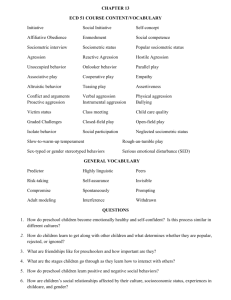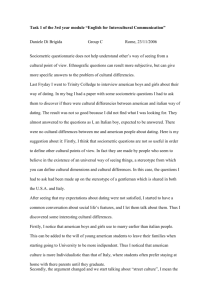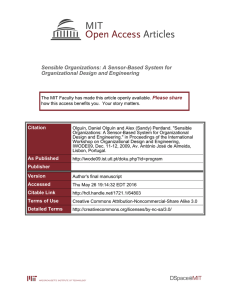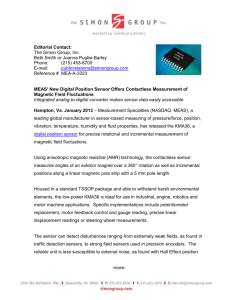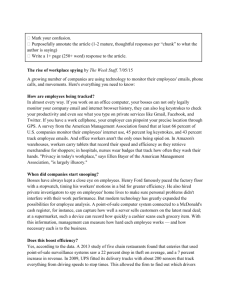Sensor-based feedback systems in organizational computing Please share
advertisement
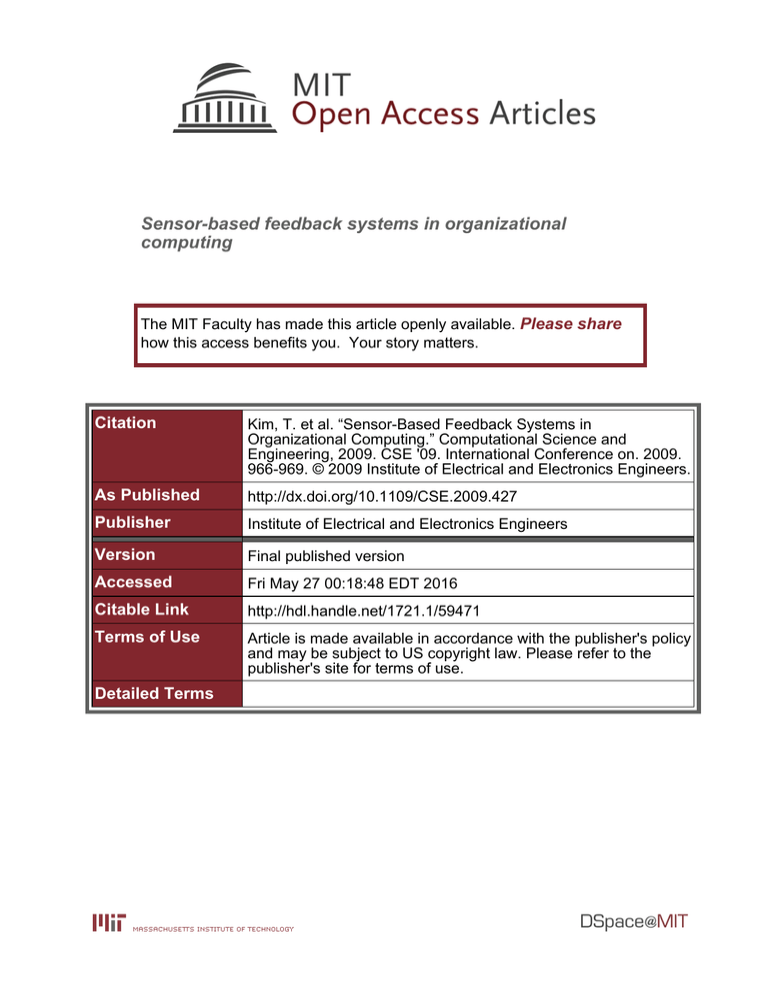
Sensor-based feedback systems in organizational
computing
The MIT Faculty has made this article openly available. Please share
how this access benefits you. Your story matters.
Citation
Kim, T. et al. “Sensor-Based Feedback Systems in
Organizational Computing.” Computational Science and
Engineering, 2009. CSE '09. International Conference on. 2009.
966-969. © 2009 Institute of Electrical and Electronics Engineers.
As Published
http://dx.doi.org/10.1109/CSE.2009.427
Publisher
Institute of Electrical and Electronics Engineers
Version
Final published version
Accessed
Fri May 27 00:18:48 EDT 2016
Citable Link
http://hdl.handle.net/1721.1/59471
Terms of Use
Article is made available in accordance with the publisher's policy
and may be subject to US copyright law. Please refer to the
publisher's site for terms of use.
Detailed Terms
2009 International Conference on Computational Science and Engineering
Sensor-Based Feedback Systems
in Organizational Computing
Taemie Kim, Daniel Olguín Olguín, Benjamin N. Waber, and Alex (Sandy) Pentland
MIT Media Laboratory, Human Dynamics Group
Cambridge, MA 02139
e-mail: {taemie, dolguin, bwaber, sandy}@media.mit.edu
Abstract—Radical change is needed in today’s organizations.
While e-mail, instant messaging, wikis, prediction markets, and
the like have proliferated across myriad sectors, the fundamental
practice of management has failed to keep pace. Sensors can
automatically measure social behavior occurring in physical
space as well as the virtual world. Moreover sensor-based
feedback is poised to help create the change necessary to improve
performance and satisfaction of workers. In this paper we
summarize previous work on sensor-based feedback systems and
propose new systems at the individual, group, and organizational
level. Our goal is to help direct future research towards these
promising avenues.
II.
A. Individual-level feedback
Feedback from sensor data has not been used frequently
within organizations to effect individual behavior, although
there are some notable exceptions. Most of these are centered
around employees who interact directly with customers (call
center employees, salespeople) or people who do not spend
most of their time in a single location (truck drivers, delivery
men). In the vast majority of these cases, however, this
feedback is not sent to the employees themselves but rather
their managers. Truck fleet owners can track their drivers
using GPS units, getting real time location or aggregated
reports [8]. Call center managers listen to their employees’
calls so they can give them pointers. This clearly indicates a
gap for which sensing-based systems can provide individual
level feedback.
Keywords: sensor-based feedback systems, organizational
engineering, sociometric badges.
I.
BACKGROUND
INTRODUCTION
Sensor networks have been widely used to monitor
environmental conditions [10, 20]. However, they have not
been widely employed to study human behavior in
organizations. Most automatic decision-support systems do not
incorporate sensor data from human behavior and social
interactions at the workplace. We believe that the analysis of
interactions within the workplace can radically improve the
functioning of an organization. By aggregating this
information, interpreting it in terms of work tasks, and
modeling the dynamics of the interactions, one can create
sensor-based feedback systems that will help us better
understand and manage complex organizations.
B. Group-level feedback
Many people have used automatic measurement of
participation to change group level communication patterns.
Researchers have encouraged balanced participation by
showing visual feedback on public displays. Bergstrom and
Karahalios [3] as well as Kyulk, Wang and Terken [13] used
tabletop interfaces to show the behavioral characteristics of
each participant. DiMicco, Pandolfo and Bender showed
similar information on a public display and measured the
effect it had on social behavior change [6]. In Basu,
Choudhury, Clarkson, and Pentland’s work [2] an actuator was
used to increase the intensity of lighting on under-participating
individuals to emphasize their presence.
In this paper we summarize previous work on sensor-based
feedback systems and propose new systems at the individual,
group, and organizational level. With rapid change occurring in
most organizations, this reinvention is necessary to take full
advantage of modern electronic and physical infrastructure.
However, most of these systems only capture speaking
time, which is just one relevant feature of social interaction.
Furthermore these systems create changes in participation but
the research did not explore the system’s effect on
performance. We aim to verify the effect of behavioral
feedback on the level of cooperativeness as well as their
communication patterns.
C. Organizational-level feedback
Performance Support Systems (PSS) offer significant
opportunities to measure and improve the performance of
people and organizations. A PSS is an “optimized body of
integrated online and offline methods and resources providing
978-0-7695-3823-5/09 $26.00 © 2009 IEEE
DOI 10.1109/CSE.2009.427
966
what performers need, when they need it, in the form they
need it in, so that they can perform in ways that meet
organizational objectives” [16]. The ADAPTS project [4]
provides an intelligent, adaptive electronic performance
support system for maintaining complex equipment. ADAPTS
maintains a dynamic characterization of a technician's
knowledge, experience, and preferences in the form of a user
model. This model influences the diagnostic strategy,
technical information content, and navigation support offered
to a technician. ConceptMaps [9] is an example of a
knowledge visualization tool that can be combined with recent
technology to provide integration between knowledge and
information visualizations. Xiahou, Chen, and Huang [19]
present a wearable system to support learning and training and
operation of maintenance activity in industrial settings. These
systems usually include the following feedback components:
learning, guidance and tracking, task-structuring support,
information support and coaching, knowledge management,
communication, and collaboration tools. In the following
section we propose enhancing PSS with human behavior
sensor data in order to create sensor-based feedback systems
applicable at the individual, group and organizational levels.
III.
Figure 1. The sociometric badge, an example of a sensor-based system that
detects individual and social behavior in real-time allowing real-time feedback.
A sensor-based feedback system for organizational
computing consists of environmental and wearable sensors,
computers, and software that continuously and automatically
measure individual and collective patterns of behavior,
identifies organizational structures, quantifies group dynamics,
and provides feedback to its users. The purpose of such a
system is to improve productivity, efficiency, and/or
communication patterns within an organization.
PROPOSED SCENARIOS
We have developed a set of tools and methods to
automatically capture, measure, and analyze human behavior
in organizational settings in order to improve performance and
optimize organizational structures and decisions i.e. office
layout, team formation, and organizational structure [14]. Our
goal is to be able to map behavioral patterns to quantifiable
outcomes and provide employees and managers with feedback
that allows them to adjust their behavior in order to optimize a
desired outcome. Our proposed approach includes the
following steps:
1.
2.
3.
4.
5.
6.
A. Web-based individual feedback
Performance dashboards are becoming increasingly
popular, but how to structure this feedback, particularly when
it comes from sensor data, is an unanswered question. We
believe that pushing individual level feedback onto the web
will allow users that are increasingly more familiar with social
networking sites, wikis, and other online media to interact
with their data in a much richer way. This approach also
dovetails nicely with recent systems that create corporate
networking sites, such as Beehive [7], where users are already
used to managing privacy settings and the like. Naturally this
becomes even more crucial when dealing with detailed sensor
data.
Capturing the interactions and social behavior of
employees, managers, and customers using wearable
and/or environmental sensors such as the sociometric
badges (figure 1) [14]. Other sources of information
that can be incorporated into the system are any form
of digital records (i.e. e-mail, chat, phone logs).
Performing data mining and pattern recognition to
extract meaningful information from these data.
Combining the extracted information with
performance data (i.e. sales, tasks, timing) and
finding
relationships
between
objective
measurements and performance outcomes.
Generating feedback in the form of graphs,
interactive visualizations, reports, or real-time audiovisual feedback for employees, managers and/or
customers in order to improve organizational
performance and customer satisfaction.
Behavior simulation, prediction and modification.
Continuous
measurement
and
performance
assessment.
Choosing levels of abstraction with which to show
individual feedback is also crucial. One has to balance the
desire to show unfiltered data with the knowledge that
interpretation of such data is difficult at best and quite prone to
error. When giving people feedback on their movement
patterns, for example, rather than just showing the energy of
movement, tying this data to physical or psychological states
using easy to understand icons would be preferable.
Interestingly, SNIF, which sells dog tag sensors for pet use,
employs exactly this approach for feedback on dog behavior
[15]. By providing individual and social behavioral data to
individuals, we aim to help self-assessment and behavior
modification which can lead to higher job satisfaction and
performance.
967
B. Group-level feedback
The small group is a vital unit that has to function properly
for the success of any organization. Feedback on group
dynamics has been proven to help with the performance of
small group collaboration. We propose a system to detect
group dynamics and provide feedback according to the
group’s goal. By synchronizing multiple wearers’ sociometric
data, we are able to get information such as turn taking,
influence, body movement mimicry, and similarities in
behavior. We then visualize sociometric data to provide
feedback on their group dynamics. The feedback is visualized
on the mobile phone of each participant. For it to be a
persuasive interface, encouraging change in group behavior,
visualization should be designed to guide the direction of
change.
Laboratory study results of initial prototypes show that
sociometric feedback changes groups to have higher
interactivity levels and more communication. This effect was
stronger for groups collaborating remotely, reducing the
dynamical difference between co-located and distributed
collaboration [11]. In a different study we found that groups
with feedback showed more solo speaking time and less body
movement. More interestingly when given feedback on their
communication
patterns,
individuals
became
more
cooperative, increasing the overall performance of the group
[12]. These results are promising as they verify that real-time
sociometric feedback can indeed change group dynamics and
their performance.
Figure 2. The social network diagram created using sociometric badges. The
structure of the diagram reveals the cohesiveness of each team (color coded).
2) Tightening
Social connectors are vital for any social system to thrive
[4]. These are the people that make our lives better and help
society as a whole by connecting disparate social segments
together. Connectors tend to be more productive than nonconnectors [1], and in organizations where this skill is
recognized and rewarded the organization benefits [5]. But
why can’t we all be social connectors? What if everyone
could tap into the same skills used by these individuals?
Imagine an application that lets people know when their
social connections could help their friends. While a natural
connector may have picked up on this information, it is a
difficult task for most people, who do not have wider
knowledge of the structure of the social systems that they
inhabit [5]. By creating an Augmented Social Reality tool that
sent out such notifications we would allow everyone to
become a social connector. Naturally, for this approach to
work we must first acquire knowledge of who knows whom:
the “true” social network. To quantify these ties a wearable
sensor such as the sociometric badge is the obvious tool of
choice, since it is an accurate and objective measurement
device and could be used as an ID replacement in most formal
organizations [14].
C. Organizational-level feedback and Responsive Buildings
1) Organizational Engineering using Social Network
Analysis
We have recently deployed our organizational engineering
system at a bank’s call center, where a group of 80 employees
(working in four different teams) and managers used
sociometric badges for a month. Daily productivity metrics
have been made available to us: number of phone calls
handled, average call handle time, speaking time, and system
use time, among others. Preliminary results seem to indicate
that cohesion in the face-to-face social network (captured with
our system’s wearable sensors, figure 2) is negatively
correlated with the average handle time. This is in agreement
with the results obtained by Wu, Waber, Aral, Brynjolfsson,
and Pentland [18] and has several implications for the call
center’s operations. We are currently working on feedback
mechanisms to present real-time information to managers and
are also preparing general recommendations to improve the
performance in the call center. For instance, one possible
intervention would be to change the way employee’s breaks
are currently scheduled. Instead of minimizing the number of
people taking a break at the same time (how it is currently
done), we are changing the break schedule so that more people
working in the same team can take a break at the same time.
This would allow members of the teams to form more
cohesive ties over time, and allow knowledge sharing, which
in turn would lead to a reduction in the average call handle
time.
For two people who have no friends in common to be
introduced to each other, introductions must be made through
intermediaries. This will create a patchwork of ties that would
slowly close the gap between these two users in a process we
call tightening. Tightening consists of creating a link between
two target users by introducing them to users that they do not
have prior ties with and are on the shortest path in the social
network between the targets. The new ties formed in this
process must bring the targets strictly closer to each other as
long as there is not resistance from a user on the shortest path.
If a user does not want to be introduced with one of the
targets, then we can attempt to circumvent them by taking the
next shortest path through the network. Both targets connect to
each other when they have a common acquaintance who
introduces them.
968
[3]
3) Responsive Buildings
Another method that can be utilized is an approach that we
call Responsive Buildings. Today, buildings and office layouts
change at a glacial pace. Although companies build new
corporate headquarters that they expect to occupy for 50 years,
they design these buildings with fixed walls and doors to deal
with the organization as it exists today. By using sensors we
can now think of modifying these structures with knowledge
of the interaction patterns occurring within the building in
real-time according to the preferences of the occupants. This
contrasts starkly with the more common approach in
architecture of having doors and walls respond without
concern for the larger social system that occupies the
workplace.
[4]
[5]
[6]
[7]
[8]
Office layout is one of the primary driving forces behind
interactions in the workplace. People talk much more to
people who are close to them, and if someone has to go
through more effort to interact, the probability that they will
interact if they do not know each other beforehand degrades.
Therefore we can attempt to influence interaction patterns
much more subtly using architecture. We could encourage or
discourage interaction by making robotic cubicle walls that we
could programmatically lower or raise based on people’s
preferences. We could also do this using window shades as
cubicle walls, again raising or lowering them based on
preferences.
To influence communication patterns across
entire groups, we could program movable partitions that
would place themselves in the space between groups to create
more enclosed spaces.
IV.
[9]
[10]
[11]
[12]
[13]
CONCLUSIONS
Radical change is needed in today’s organizations. While
e-mail, instant messaging, wikis, prediction markets, and the
like have proliferated across myriad sectors, the fundamental
practice of management has failed to keep pace. Sensors and
sensor-based feedback are poised to help create the change
necessary to deal with these problems. At the individual level
we can begin to help people understand how their normal
behaviors can have startling effects on their job performance
and happiness. We can use sensors to tune group dynamics so
meetings are more in line with group goals and avoid common
psychological pitfalls. Finally, we can harness these massive
data streams to give people an enhanced sense of their
organization’s social environment, shifting focus from formal
ties to the arguably more important informal ones. These
changes may even manifest themselves in the physical
architecture of organizational spaces, creating Responsive
Buildings. The opportunities are even more numerous than
was described here, but we hope this paper will direct future
research towards these promising avenues, and help create
Sensible Organizations.
[14]
[15]
[16]
[17]
[18]
[19]
REFERENCES
[1]
[2]
[20]
Baker, Wayne E. Achieving Success Through Social Capital: Tapping
Hidden Resources in Your Personal and Business Networks. JosseyBass, 2000.
Basu, S., T. Choudhury, B. Clarkson, and A. Pentland. "Towards
Measuring Human Interactions in Conversational Settings." Proceedings
of the IEEE International Workshop on Cues in Communication. 2001.
969
Bergstrom, T., and K. Karahalios. "Conversation Clock: Visualizing
audio patterns in co-located groups." Proceedings of the 40th Annual
Hawaii International Conference on System Sciences. IEEE Computer
Society, 2007.
Brusilovsky, P., and Cooper, D. ADAPTS: Adaptive hypermedia for a
Web-based performance support system. Proceedings of the 2nd
Workshop on Adaptive Systems and User Modeling on the WWW,
1999.
Cross, R, and A Parker. The Hidden Power of Social Networks. Boston,
MA USA: Harvard Business School Publishing, 2004.
DiMicco, J. M., A. Pandolfo, and W. Bender. "Influencing group
participation with a shared display ." Proceedings of the ACM
Conference on Computer Supported Cooperative Work. New York, NY,
2004. 614-623.
DiMicco, Joan M, David R Millen, Werner Geyer, and Casey Dugan.
"Research on the Use of Social Software in the Workplace." Computer
Supported Collaborative Work. San Diego, CA, USA, 2008.
GPS-planet website 2009. http://www.gps-planet.com/gpsbuddy1.html
(accessed June 19, 2009).
Jarvis, S. and Shook, B. Performance Management, the Role of a
Learning Management System in an Electronic Performance Support
System. Proceedings of the International Training Exhibition and
Conference (ITEC), 2006.
Johnstone, I., J. Nicholson, B. Shehzad, and J. Slipp. "Experiences from
a wireless sensor network deployment in a petroleum environment."
Proceedings of the 2007 international conference on Wireless
communications and mobile computing. Honolulu, Hawaii: ACM, 2007.
382-387.
Kim, T., A. Chang, L. Holland, and A. Pentland. "Meeting mediator:
enhancing group collaborationusing sociometric feedback." Proceedings
of the ACM Conference on Computer Supported Cooperative Work.
New York, NY, 2008. 457-466.
Kim, T., L. Bian, P. Hinds, and A. Pentland. "Encouraging Cooperation
using Sociometric Feedback." Submitted to the ACM Conference on
Computer Supported Cooperative Work . 2010.
Kyulk, O., J. Wang, and J. Terken. "Real-Time Feedback on Nonverbal
Behavior to Enhance Social Dynamics in Small Group Meetings ."
Proceedings of the Conference of Machine Learning for Multi-modal
Interaction. 2005. 150-161.
Olguin-Olguin, Daniel, Benjamin Waber, Taemie Kim, Akshay Mohan,
Koji Ara, and Alex Pentland. "Sensible Organizations: Technology and
Methodology for Automatically Measuring Organizational Behavior."
IEEE Transactions on Systems, Man, and Cybernetics-Part B:
Cybernetics, 2009: 43-55.
SNIF Home Page. 2009. http://www.sniftag.com (accessed June 19,
2009).
Villachica, Steven W., Deborah L. Stone, and John Endicott.
"Performance Support Systems." In Handbook of Human Performance
Technology. Principles, Practices, and Potential, by James A. Pershing,
539-566. Wiley, 2006.
Waber, B., Olguin Olguin, D., Kim, T., Mohan, A., Ara, K., and
Pentland, A. Organizational engineering using sociometric
bages. In Proceedings of the 11th International Symposium
on Wearable Computers, 2007.
Wu, L., Waber, B. N., Aral, S., Brynjolfsson, E., & Pentland, A. (2008).
Mining Face-to-Face Interaction Networks using Sociometric Badges:
Predicting Productivity in an IT Configuration Task . Proceedings of the
International Conference on Information Systems. Paris.
Xiahou, S. and Chen, D. and Huang, Z. A Wearable learning and support
system for manufacture application. Lecture Notes in Computer Science.
Vol. 3942. Springer, 2006.
Xu, N., et al. "A wireless sensor network for structural monitoring."
Proceedings of the 2nd International Conference on Embedded
Networked. Baltimore, MD, 2004.
